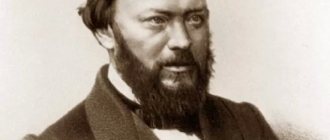A.N. Ostrovsky "Thunderstorm". Family and social conflict in the drama "The Thunderstorm".
Subject. A.N. Ostrovsky “The Thunderstorm”. Family and social conflict in the drama “The Thunderstorm”.
Goals:
find out the main stages in the development of the external conflict “Thunderstorms”, the motivation of the characters in the play participating in the conflict; various stage interpretations of the role of Katerina, compare and contrast them.
During the classes
I.Organizational moment
II.Working with text
What problems does Ostrovsky reveal in his work?
Define the word “conflict”.
Did Katerina manage to escape from this “dark kingdom”? Was there another way?
In The Thunderstorm, Ostrovsky, operating with a small number of characters, managed to reveal several problems at once. Firstly, this is, of course, a social conflict, a clash between “fathers” and “children”, their points of view (and if we resort to generalization, then two historical eras). Kabanova and Dikoy belong to the older generation, who actively express their opinions, and Katerina, Tikhon, Varvara, Kudryash and Boris to the younger generation. Kabanova is sure that order in the house, control over everything that happens in it, is the key to a healthy life. The correct life, according to her concepts, is to follow the house-building orders and unquestioningly obey the elder (in this case, her, because she sees no other suitable candidate). Seeing that not all of her demands are being met, she fears for the future, both hers and her children’s, because her world is collapsing, and what should come to replace it seems chaos to her. She is trying with all her might to maintain the old order, because... He simply cannot live any other way; Therefore, the figure of Kabanova takes on a tragic connotation. In Diky, on the contrary, there is no hint of tragedy. He is confident that he is right and that everyone around him depends only on him, so he allows himself to do unimaginably vile acts, which is typical tyranny.
The younger generation looks at things a little differently. All of them, with the exception of Boris, who for some unknown reason tolerates his uncle’s willfulness, to one degree or another express protest against oppression by their elders. Kudryash scolds Dikiy, thus not allowing himself to be offended. Varvara goes for walks at night, secretly from her mother, and then runs away with Kudryash. Boris, as already mentioned, endures Dikiy’s bullying and thereby shows some kind of inability to live independently. Such is Tikhon. His absolute dependence on his mother is due to the fact that he grew up in an environment where someone necessarily commands, and someone obeys.
The most difficult and tragic fate is Katerina’s protest. Without clearly understanding what she needs, she knows one thing: she can’t live like that. Of course, she is part of the patriarchal Kalinov and lives by his laws, but at some point all this becomes unbearable for her. The “dark kingdom” gives a crack, and through it, from its very depths, a “light ray” breaks through. Katerina’s unclear desire to escape from this musty world somewhere (she is a maximalist, like Kabanova, only one option is possible for her: either everything or nothing) led her into the river, but thereby she resolved the conflict with her own destiny in her favor: Instead of the fate prepared for her to exist within four walls, always trampled upon by her mother-in-law and husband, she chose freedom, even at the cost of her life.
For quite a long time, it was believed that Ostrovsky took the plot of “The Thunderstorm” from the life of the Kostroma merchants, that it was based on the Klykov case, which was sensational in Kostroma at the end of the summer of 1859. Until the beginning of the 20th century, Kostroma residents proudly pointed to the site of Katerina’s suicide - a gazebo at the end of a small boulevard, which in those years literally hung over the Volga. They also showed the house where she lived, next to the Church of the Assumption. And when “The Thunderstorm” was first performed on the stage of the Kostroma Theater, the artists made themselves up “to look like the Klykovs.”
Kostroma local historians then thoroughly examined the “Klykovo Case” in the archives and, with documents in hand, came to the conclusion that it was this story that Ostrovsky used in his work on “The Thunderstorm.” The coincidences were almost literal. A.P. Klykova was extradited at the age of sixteen to a gloomy and unsociable merchant family, consisting of old parents, a son and an unmarried daughter. The mistress of the house, stern and obstinate, depersonalized her husband and children with her despotism. She forced her young daughter-in-law to do any menial work and refused her requests to see her family. At the time of the drama, Klykova was 19 years old. In the past, she was brought up in love and affection by her doting grandmother, she was cheerful, cheerful, and lively. Now she found herself unkind and alien in the family. Her young husband, Klykov, a carefree and apathetic man, could not protect his wife from the oppression of his mother-in-law and treated her indifferently. The Klykovs had no children. And then another man stood in the way of the young woman, Maryin, an employee at the post office. Suspicions and scenes of jealousy began. It ended with the fact that on November 10, 1859, the body of A.P. Klykova was found in the Volga. A long trial began, which received wide publicity even outside the Kostroma province, and none of the Kostroma residents doubted that Ostrovsky had used the materials of this case in “The Thunderstorm.”
Many decades passed before researchers of Ostrovsky’s work established for sure that “The Thunderstorm” was written before the Kostroma merchant Klykova rushed into the Volga.
Conclusion:
Such cases happened among merchants, because the patriarchal foundations of society did not allow them to live freely, independently, but subjugated and enslaved. A woman could not love whoever she wanted, she was not married for love, and she had to accept her fate. Katerina Kabanova did not accept it, just like A.P. Klykova.
III . Lesson summary
IV .
Homework
Think about the questions “What is the symbolism of the name of the drama “The Thunderstorm”?”
Why did Ostrovsky call the play a drama and not a tragedy?
Get acquainted with the statements about Katerina by critics (Dobrolyubov “A Ray of Light in a Dark Kingdom”, Pisarev “Motives of Russian Drama”); decide whose point of view is closer;
a) continue the quote:
| Dobrolyubov | Pisarev |
| Katerina’s character is... | Dobrolyubov assumed the identity of Katerina... |
| Decisive, integral Russian... | Not a single bright phenomenon... |
| This is character par excellence... | What kind of harsh virtue is this... |
| Katerina does everything... | Dobrolyubov found...the attractive sides of Katerina,... |
| . In Katerina we see protest... | Education and life could not give... |
| Such liberation is bitter; but what to do when... | Katerina cuts through lingering knots... |
| We are glad to see deliverance... | Who does not know how to do anything to alleviate their own and others’ suffering... |
Popular writings
- The power of nature - essay
Life on earth is beautiful and amazing! Nature is the “mother” of all life on the planet. Without it, the earth would be a gray, dry and deserted space. Nature is like a holy spring - Essay Where the Motherland Begins
It seems that the question “Where does the Motherland begin?” should not be controversial. After all, the Motherland is the place where a person was born - everything is simple. But no. Everyone has their own opinion on this topic. And to some extent, everyone is right in their own way. - Essay Famous TV presenter (Andrey Malakhov)
In ancient times, people used to gather around the fire in the evenings. Perhaps in open spaces, sometimes, probably in caves, and then the narrator appeared. He told different stories




